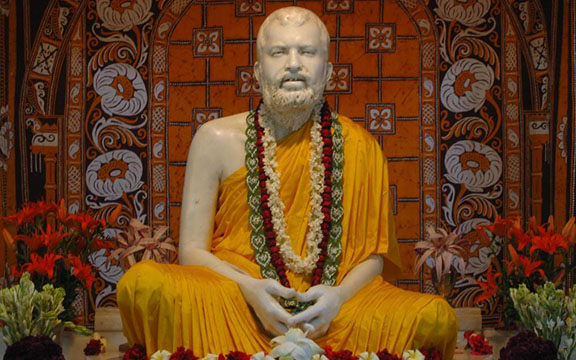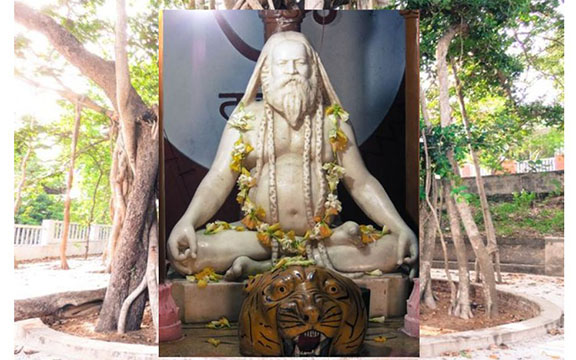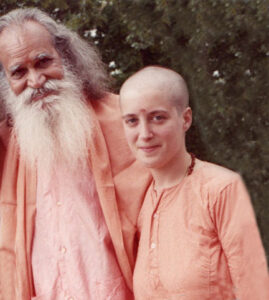
Photo: Murti (sacred statue) of Sri Ramakrishna Paramahamsa.
In Part 8 of this series, we explored how Ramaswamy (Swami Satchidananda’s birth name) delved deeply into his spiritual yearnings, engaging with sacred texts and absorbing the wisdom of saints. Another profound influence during this formative period was the life and teachings of Sri Ramakrishna Paramahamsa. The threads of Sri Ramakrishna’s life would weave through the tapestry of Ramaswamy’s spiritual journey, echoing deeply in his transformation into Swami Satchidananda.
Sri Ramakrishna’s Journey to the Divine
Sri Ramakrishna was born in Bengal in 1836 and from an early age exhibited an intense devotion to God, often entering ecstatic states. This “God-intoxicated” nature revealed to his disciples a path to the Divine characterized by sincere prayer and heartfelt yearning. To many, his life story is not merely that of a spiritual seeker but an embodiment of spiritual realization—a shining example that the Absolute can be known intimately and directly.
As a young man, Sri Ramakrishna served as the priest at the Kali Temple at Dakshineswar, a village near Kolkata (Calcutta). This temple, founded and designed by Rani Rasmani, was unique in its intention to embody the harmony of different Hindu paths: Shaktism, Vaishnavism, and Shaivism. This broad spiritual vision, along with his own upbringing, deeply influenced Ramakrishna’s later teachings, which emphasized the unity of all paths to God. He would affirm this nonsectarian view throughout his life, proclaiming that all faiths lead to the same Divine truth—a hallmark that also would become central in Swami Satchidananda’s teachings in the West.
Sri Ramakrishna was not content to know the Divine through one approach alone. Between 1855 and 1874, he immersed himself in many spiritual traditions. Practicing Tantra, Vaishnavism, Advaita Vedanta, Islam, and Christianity, he sought to experience God in all forms and paths. His first significant spiritual attainment came in 1856 when he had a vision of the Divine Mother, Kali, as a result of fervent prayer and worship. Under the guidance of Bhairavi Brahmani, a female Tantrika and Vaishnava adept, Sri Ramakrishna further deepened his sadhana (spiritual practice), embracing both devotional and Tantric disciplines.
Ramaswamy, who was raised in a Shaivite family who had a Guru from the Tantrik tradition, felt a profound resonance with Sri Ramakrishna’s spiritual life. Ramaswamy, too, would soon engage in Tantrik study and practices. Sri Ramakrishna’s eclectic and inclusive approach would help shape Ramaswamy’s understanding of the Absolute, harmonizing the great wisdom of many paths into a single, unified spiritual vision.
A Realization of Non-Duality and Unity*
In 1864, under the tutelage of the Advaitin monk Totapuri, Sri Ramakrishna delved into the non-dual teachings of Advaita Vedanta. In a short period, he attained nirvikalpa samadhi, a state where the consciousness of duality dissolves into the realization of the one, undivided Reality—Brahman. Totapuri’s teachings on the essence of Advaita were pivotal, yet after Totapuri left, Sri Ramakrishna remained in a heightened state of samadhi for six months until a command from the Goddess Kali brought him back to a state known as “bhavamukha,” a place between the relative and the Absolute.

Photo: Murti of Sri Jogeswar Digambar Paramhansa Totapuri Maharaj (known as “Totapuri Baba”).
This pivotal state of consciousness—bhavamukha—allowed Sri Ramakrishna to revel in both the personal and impersonal aspects of the Divine. In this realization, he would find harmony between the paths of bhakti (devotion) and jnana (knowledge), merging the intimate, loving relationship with God and the impersonal, all-encompassing Truth of non-duality. This balance between devotion and knowledge, love and wisdom, would also be central in Swami Satchidananda’s teachings, creating a harmonious blend of bhakti and jnana in his own spiritual realization.
Sri Ramakrishna’s explorations did not end there. He practiced Islamic sadhana under the guidance of a Muslim teacher, realized the Divine in the form of Allah, and then delved into the teachings of Christianity, eventually experiencing a vision of Jesus that deeply moved him. In his later years, Sri Ramakrishna would reflect, “I had to practice each religion for a time—Hinduism, Islam, Christianity… I realized that there is only one God toward whom all are traveling; but the paths are different.”
These words embody the spiritual unity that Ramaswamy, later as Swami Satchidananda, would carry forward in his life. His motto, “Truth is one, paths are many,” echoes the core of Sri Ramakrishna’s own God-Realization—a Realization not born of intellectual reasoning but of direct spiritual experience.
The Vision of Vijnana Vedanta
Sri Ramakrishna’s philosophy is not easily categorized. As suggested by Swami Medhanandaji, a Ramakrishna Order monk and academic philosopher, Sri Ramakrishna’s approach may be best described as “Vijnana Vedanta”—a philosophy that seeks to harmonize various seemingly conflicting religious beliefs, philosophies, and practices. From the expansive standpoint of vijnana, the Absolute is both with form and without form, both personal and impersonal, immanent in the universe and yet transcendent beyond it. This holistic view is the meeting point where devotion and knowledge embrace each other, where the dualities of existence merge into a profound recognition of the oneness of God, Brahman, the Divine.
For Sri Ramakrishna, the world was not a mere illusion to be dismissed as “maya.” Instead, it was seen as a divine play for those who see the truth behind its veils. “Why should the world be false?” he asked. “That is a process of vichara [inquiry]. In the process, you take that to be false to discover the Reality. After you discover the Reality, it is all God.”
This understanding shaped the way both Sri Ramakrishna and Swami Satchidananda saw the world—not as a place to be shunned or renounced in despair but as a divine play, a manifestation of God to be experienced with awe and reverence. Swami Sarvapriyananda of the Vedanta Society of New York elaborated on this beautifully: “Maya means ‘fun’ in Bengali. But it’s not just fun; it’s a kind of holy fun, sacred fun… When you realize that you are Brahman… then it becomes a mansion of delight; otherwise, it’s a horror story.”
Swami Satchidananda echoed these profound insights in his own words:
“Do you want to know the secret of life? It is very simple. Play your part well. But don’t identify with that part. How? Remember who you are. You have a role to play in life. So act well, but at the same time do not forget that you are acting. Then you are always safe. If you forget one side, you are in danger. If you forget the spiritual side and think that you are a completely worldly person, there’s danger that you’ll be lost in maya (illusion). If you think that you are completely spiritual and forget the world, then there is danger. People everywhere will say you are madcap, crazy. So remember who you are. You are peace and happiness personified. When you remember this, you can enjoy the world and not suffer.”
This simple yet profound teaching beautifully weaves together the threads of bhakti, and jnana, inviting us to live life fully, with the awareness of our True Nature. It reflects the same joyful celebration of life, which Sri Ramakrishna embodied—a sacred dance of the Divine within and without. For both Sri Ramakrishna and Swami Satchidananda, life itself is a journey to this most profound understanding and ultimate Realization—to the heart of God where all paths meet and we experience the Truth of the essential oneness of all.
About the Author:
 Swami Premananda, Ph.D. is a senior disciple of Sri Gurudev Swami Satchidananda and served as his personal and traveling assistant for 24 years. Her interest in the study of the spiritual roots of the Integral Yoga tradition and lineage was inspired over many years of traveling with Sri Gurudev to the various sacred sites throughout India that are a part of this tradition. She also undertook a 2-year immersion into the nondual Saiva Yoga Siddhar tradition that is at the heart of Sri Gurudev’s spiritual roots. She further studied the history, sacred texts, and teachings of Tamil Saivism including the Siddhars, bhakti poet saints, as well as the spiritual luminaries who lived in the 19th – 20th centuries and who inspired Sri Gurudev, such as Sri Ramana Maharshi, Swami Ramdas, and Swami Vivekananda. She serves as editor of Integral Yoga Magazine, Integral Yoga Publications; senior archivist for Integral Yoga Archives; and director of the Office of Sri Gurudev and His Legacy.
Swami Premananda, Ph.D. is a senior disciple of Sri Gurudev Swami Satchidananda and served as his personal and traveling assistant for 24 years. Her interest in the study of the spiritual roots of the Integral Yoga tradition and lineage was inspired over many years of traveling with Sri Gurudev to the various sacred sites throughout India that are a part of this tradition. She also undertook a 2-year immersion into the nondual Saiva Yoga Siddhar tradition that is at the heart of Sri Gurudev’s spiritual roots. She further studied the history, sacred texts, and teachings of Tamil Saivism including the Siddhars, bhakti poet saints, as well as the spiritual luminaries who lived in the 19th – 20th centuries and who inspired Sri Gurudev, such as Sri Ramana Maharshi, Swami Ramdas, and Swami Vivekananda. She serves as editor of Integral Yoga Magazine, Integral Yoga Publications; senior archivist for Integral Yoga Archives; and director of the Office of Sri Gurudev and His Legacy.

